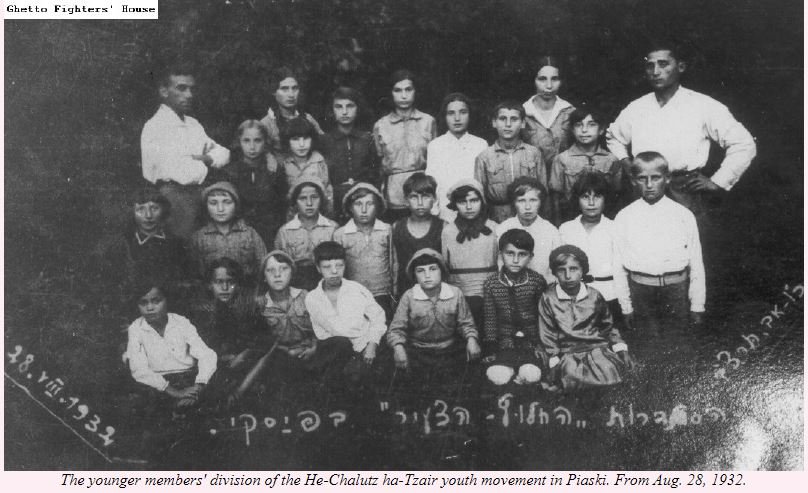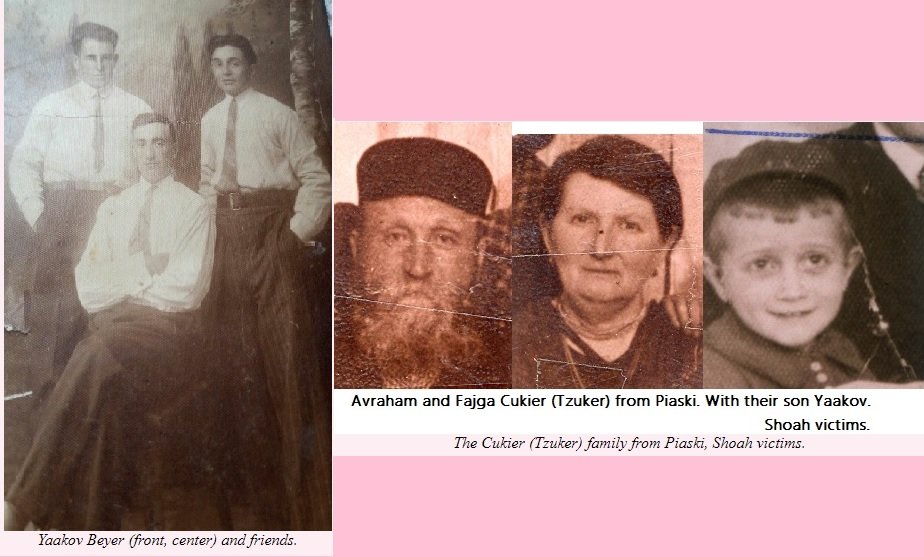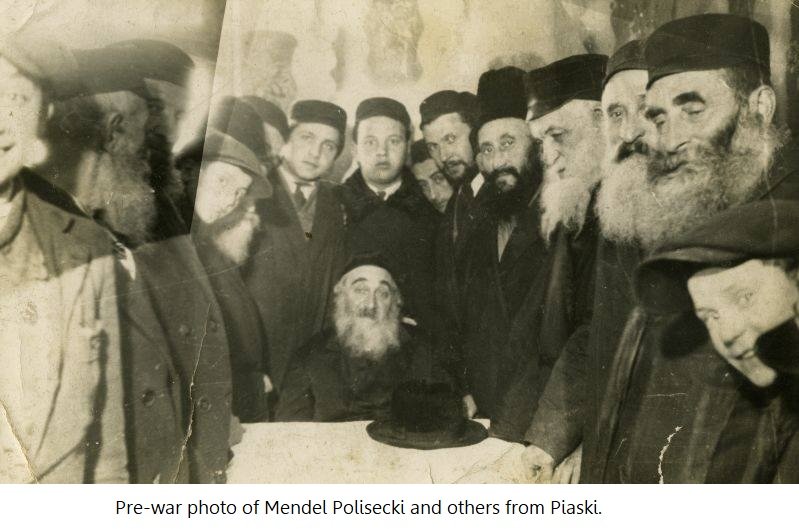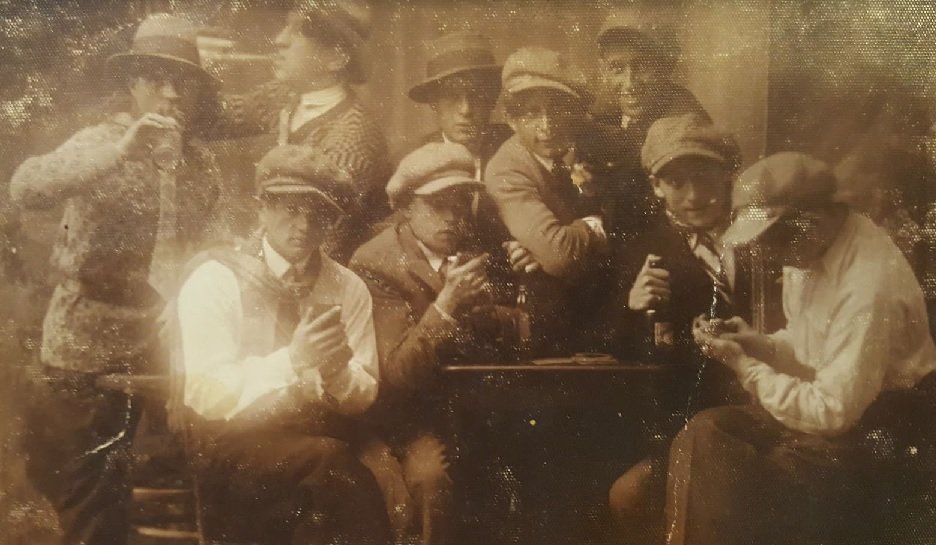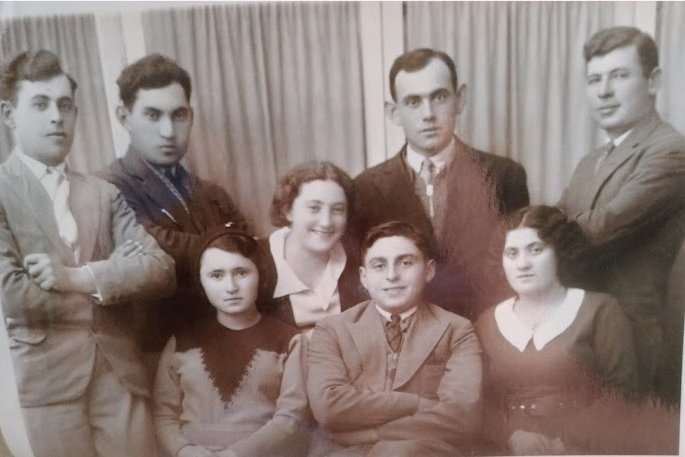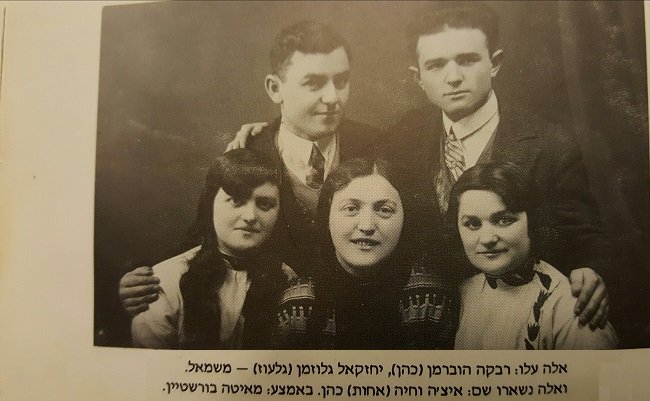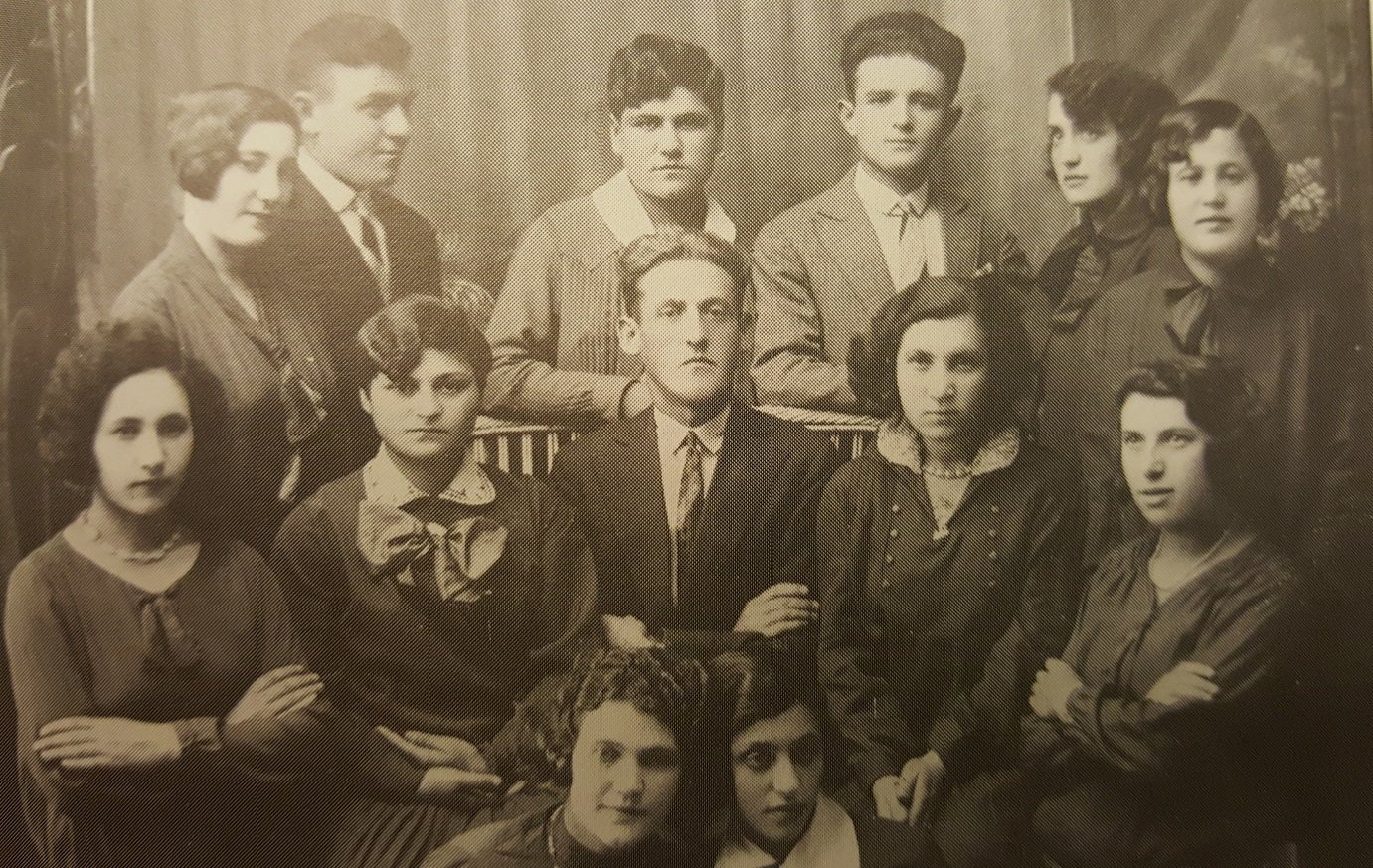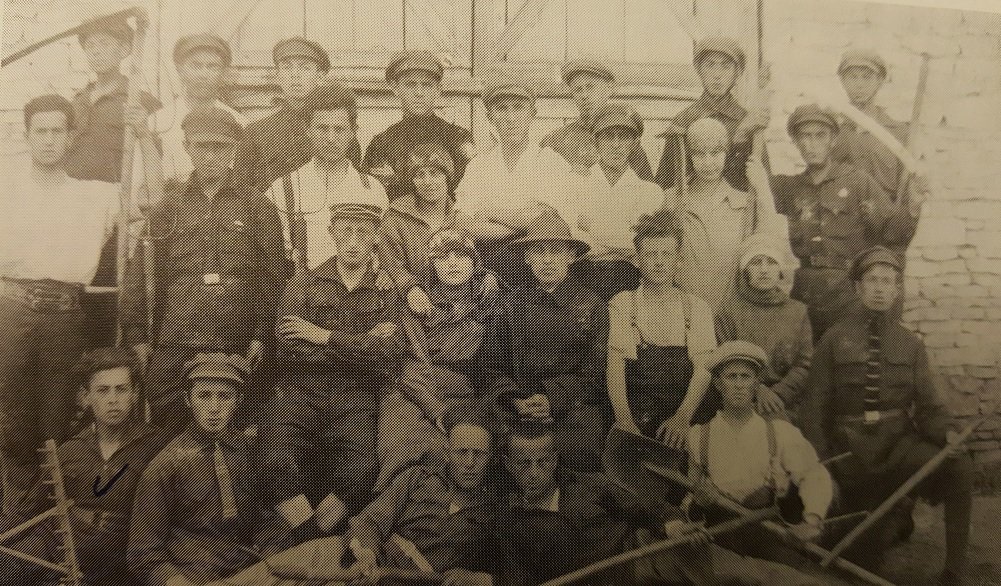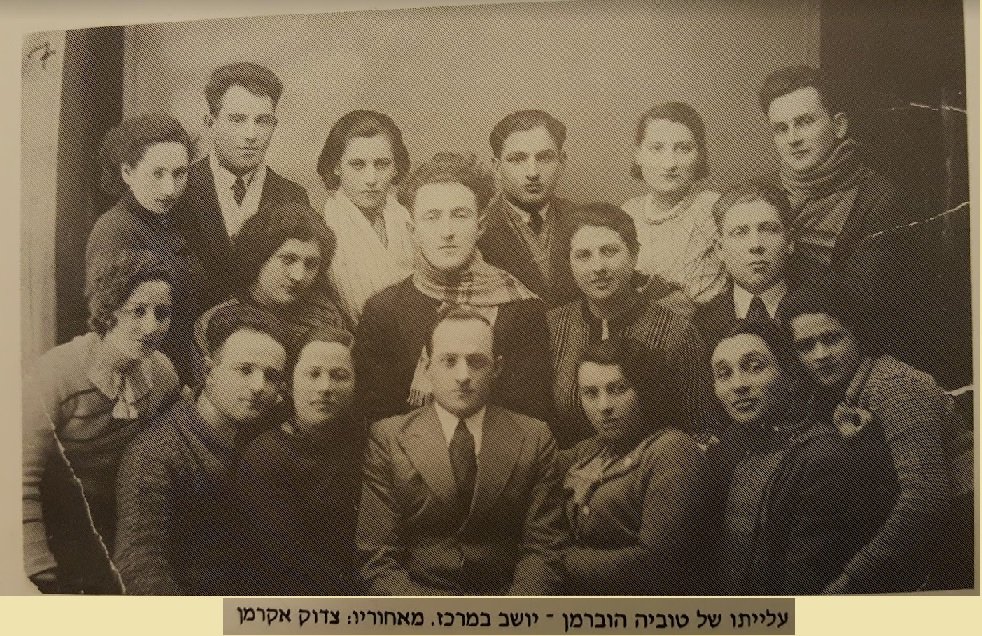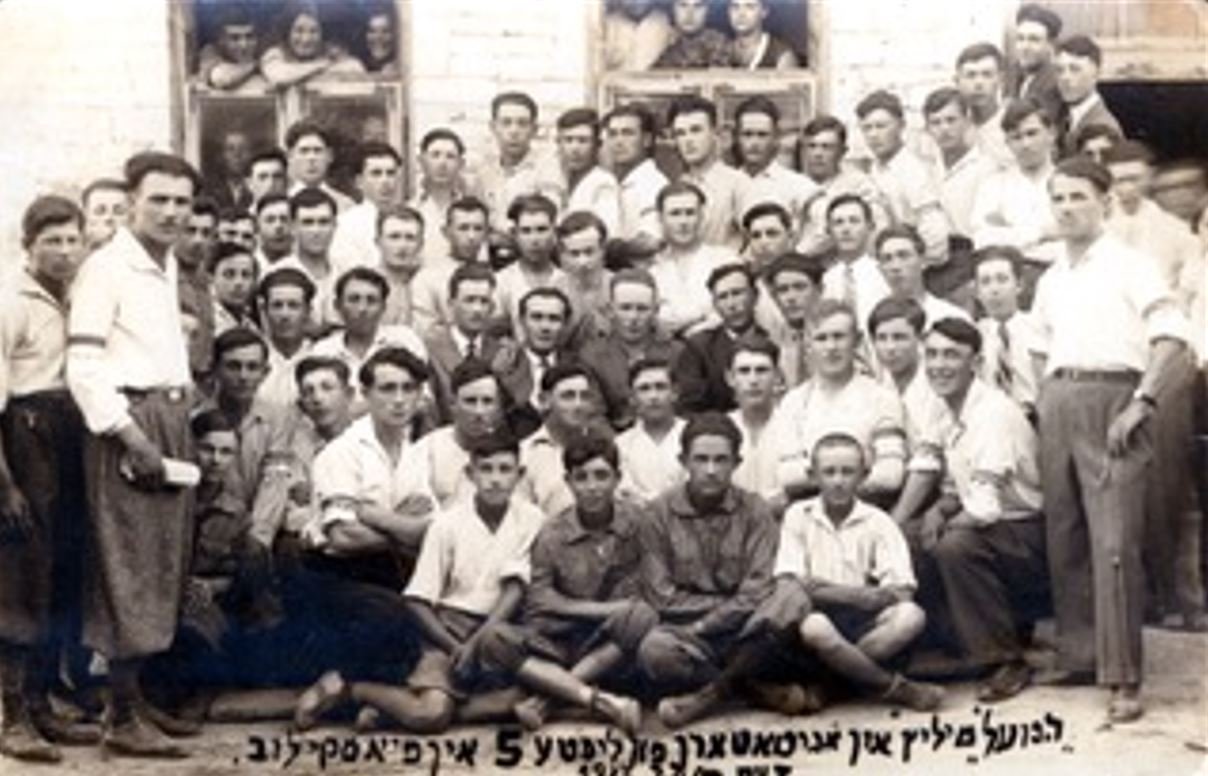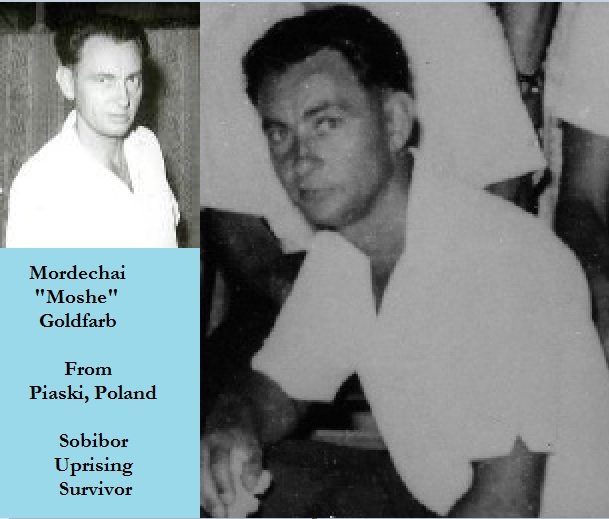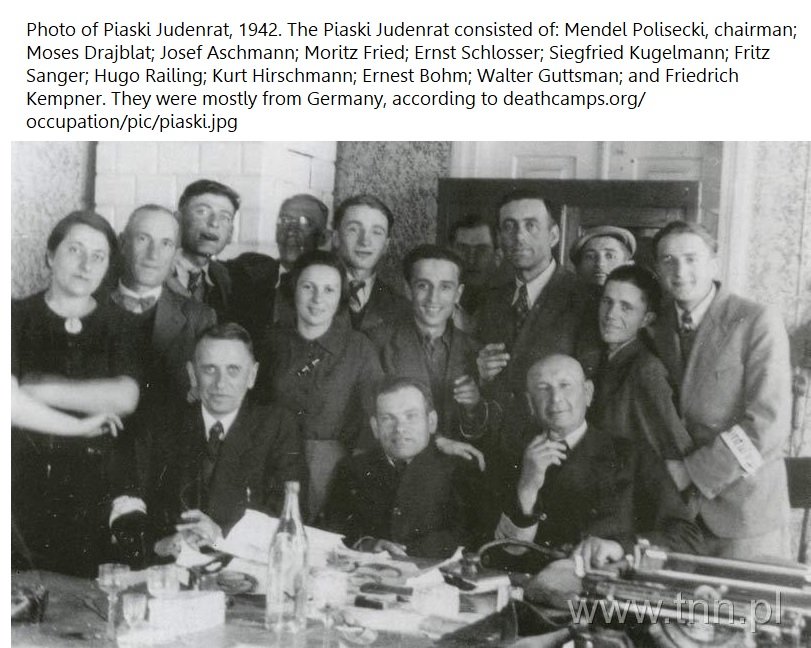Remember Jewish Piaski
Pronunciation: P-yas-kee
HISTORY OF JEWISH PIASKI
Piaski Luterskie is a city in southeast Poland, with a population of around 2,600 people. The village is 25 km. southeast of Lublin and 30 km. northwest of Krasnystaw, Poland. There are several other Piaskis throughout Poland. This Piaski is also called Piaski Luterskie.
In 1336, King Kazimierz of Poland was rumored to have let Jews begin settlement in the city. But the oldest records of Jews in Piaski date to 1578. In 1677 there were 240 people in the town, including 53 Jews. In 1787 the town numbered 1,063 inhabitants out of whom 414 were Jews. In 1827 the town numbered 1,117 people including 571 Jews. In 1864 there were 1,838 people in Piaski including 1,388 Jews. In 1884 there were 2,812 people in the town including 2,049 Jews.
In 1785, the Jews were permitted to build a synagogue. It was to be located 286 meters from the Catholic church in the village. The height could not exceed 6 meters and it was not permitted to stand out. In addition to the shul, the Jews in Piaski owned the kehilla, 12 private houses of prayer, the cheder (at 35 Lubelska Street), the Zionistic elementary school called "Tarbut", two libraries and two cemeteries. The Jewish community lived around the old market square (today there are buildings of the Housing Cooperative) and on both sides of Lubelska Street. Until the war, Jews possessed their own mills, oil mills, vinegar manufacturing company, tannery, a dozen or so workshops, and many other stores. A mill in the town was owned by Hochman (in the courtyard of 47 Lubelska Street). A second mill was owned by the Wajzer brothers. It stood by the Gielczewka River -- next to the lock. It was made of wood and divided into two parts: industrial used for grinding flour and utility room intended for farmers.
The Jewish community in Piaski was divided into two groups: Orthodox and Reform. The rich Jews in the community isolated themselves from the rest of the Jewish population. The poor Jews stuck together. Piaski was famous in the whole vicinity for its fairs, which took place every Wednesday. Sellers from various towns of Poland came to visit them. They were organized on the square near the synagogue.
In 1921 the town numbered 3,974 inhabitants out of whom 2,674 were Jewish. The Jewish employees in the city in 1930 included Moshe Licht, the rabbi; S. Rychter, cantor; Dorfsman, community head; A. Fajgenbaum, ritual slaughterer; and three others: M. Szryft, A. Grafsztajn, and M. Frydling. Prayer houses in Piaski were operated by Herszek Bronsztejn, Herszon Cukier, Motel Eikenbaum,
Gecel Guthac, Josef and Aron Hochman, Szaja Korn, Mordka Lipszyc, Nuta Szarp, Gecel Wajs, Herszek Wajzer, and Szaja Zycer. Polei Zion organization members in Piaski included: Szmuel Blusztajn, Mosze Bursztyn, Pesia Bursztyn, Gitla Bursztyn, David Gromb, Jonatan Lewinsohn, Tuwia Perec, Benjamin Rozenblatt, Beri or Dori Zimmerman and Nachman Zycer.
Jewish communities near to Piaski included in the following towns and villages: Biskupice (250-600 Jews), Bystrzejowice (unknown number of Jews), Fajslawice (150 Jews), Rybczewice (20 Jews) and Wolka Kanska (32 Jews). The Jews in these communities were murdered in the Holocaust.
PIASKI DURING THE HOLOCAUST
By 1939, Piaski had a population of 4,165 Jews. With the onset of the Nazi occupation, life became extremely harsh. Jewish shops were plundered by military policemen and their owners were beaten and humiliated. Jews were whipped and had their beards cut in public as an act of public humiliation. The Piaski Judenrat was composed of around 30 people and was chaired by the Piaski Jew named Mendel Poliseski. Other members included: Josele Aszman, Chaim Icek Gewerc and Josele Rozenblat. The Judenrat was situated at 46 Lubelska Street. On Sept. 27, 1939 the Nazis introduced a regulation requiring Jews to wear a self-identification badge with the Star of David. From that day forward Jews were not allowed to use public transportation or enter public places such as restaurants. In October, 1939 the Jewish population could not even walk freely across the main street of the town, Lubelska. And a ghetto was created in March, 1940. By fall of 1940, Jews were limited Jews to the following streets: Gardzienicka, Bednarska, Szewska, Ksieza, Rybna, Kozia, Pocztowa, Furmanska, Krotka and Koscielna. Poles who resided on streets needed by the Nazis were also displaced. The Jewish police in Piaski included 30 members, among Stefan Reinemann (Chair) and Bela Trattner.
In the fall of 1941, Jews from Lwow (Lemberg) were taken to a location called Piaski (sands), however this location is near Lwow, not the Piaski near Lublin.
The Piaski Ghetto was surrounded by a two-meter wooden fence with fixed barbed wire on top of it. The ghetto was initially divided into two parts: one on the northern side of Lubelska Street, the other one on the southern side. The ghetto reached as far as the police station on one side and Ksieza and Strazacka streets on the other side, and from the building of the German military police to the
parish church. The ghetto on the northern side was dissolved in 1942 and its residents were moved to the southern section of the ghetto. Known transports to Piaski include the following:
• 1,300 Jews from Stettin (Szczecin) on February 13, 1940;
• 4,200 Jews from Germany and Czechoslovakia in April, 1941;
• 500 Jews from Czechoslovakia in summer, 1941;
• Unknown number of Jews from Kalisz, Poland in March, 1942;
• 1,000 Jews from Mainz and Darmstadt, Germany on March 20, 1942;
• 985 Jews from Berlin, Germany on March 28, 1942;
• ~1,000 Jews from Muenchen, Bavaria on April 3, 1942;
• 989 Jews from Berlin, Germany on April 6, 1942;
... Note: 200 of the able-bodied were probably sent to Majdanek for slave labor
• 1,000 Jews from Theresienstadt Ghetto, Czechoslovakia on April 1, 1942;
• 1,000 Jews from Theresienstadt Ghetto, Czechoslovakia on April 23, 1942;
... Note: 200 of the able-bodied were probably sent to Majdanek for slave labor
• 1,000 Jews from Majdan Tatarski (Lublin) on April 25, 1942;
• 1,000 Jews from Czechoslovakia on Sept. 2 and Oct. 25, 1942;
• 1,200 Jews from Krakow in December, 1942
After the ghetto was permanently locked in 1941, those inside were forbidden to leave it. The number of Jews in the ghetto included the following (estimated): March of 1941: 4,803 Jews, January of 1942: 4,918 Jews, and May of 1942: 6,166 Jews. The numbers reached around 10, 00 Jews by November of 1943.
The ghetto was plagued by disease and hunger. Its residents stayed in cramped rooms where even a few families were forced to live. Due to the lack of space, ghetto residents slept in turns. There were three entrance gates to the ghetto which were guarded by the military policemen and the Jewish police. Jews were taken through the gates to perform cleaning work in the town or were driven to the peat mine near Dorohucza on the river. Twenty to thirty people perished in the ghetto on a daily basis. In the ghetto was
a makeshift hospital and a synagogue for praying. The ghetto was intended only as a transitional place. Beginning in November 1942, a small forced labor camp for Jews operated in Piaski, but only lasted until March or April of 1943 -- when the inmates were sent to the Trawniki Labor Camp.
Around March 16, 1942, 3,400 Jews -- including the German Jews from Stettin, who were deemed as unfit for work, were sent to Trawniki and put into a large barn at the former sugar refinery, with some Jews from Biskupice. The entire group, including some corpses of those who died in the barn of suffocation, were then transported to Belzec Death Camp the next day. Other transports to
Belzec took place in April (2,000 Jews) and November (2,000 Jews) of 1942. In October, 1942, another group of 4,000 Jews were sent to their deaths at the Sobibor Death Camp. This included a group of 3,000 Jews from the Leczna Ghetto. The southern part of the ghetto was liquidated in Nov., 1943.
Of the pre-war Jewish population of the town of Piaski, a mere 35 Jews survived the Nazi occupation. On March 17, 1943, after most Jews in Piaski were no more, an excess of 1,200 Jews from Lvov were murdered in the Piaski Ghetto as retribution for the March 16 murder of an S.S. trooper by a Jewish man.
The synagogue was destroyed on July 9, 1944 during the Russian air raids directed at German troops that stationed in the town. At present, next to the place where the synagogue stood on Strazacka Street, there is a fire station. And near the synagogue, Jews used to have a mikvah, which was also destroyed in WWII. The old Jewish cemetery in Piaski was founded in the second half of the 16th century. Some executions were carried out by the Nazis at the cemetery. After the war, the market square was constructed at the location of the old cemetery. The last burial was in the 19th century. The cemetery location was 500 Lecia St.
On Mickiewicza Street is the new Jewish cemetery, established at the end of the 19th century. In June of 1942 the Nazis forced local firefighters to dig out three ditches in the cemetery. On June 22, 1942 the Nazis murdered over 1,000 Jews, including women and children, in the cemetery. The corpses of the murdered were thrown to the ditches previously dug out. The place of this mass execution is not fenced or marked in any way. The grounds of the cemetery are also partially forest. There are only a few preserved gravestones. The oldest preserved matzeva is from 1906. In the 1990s, a German-Jewish diaspora from Augsburg erected a commemorative stone in the cemetery to the memory of those Jews who had been killed in Piaski. It was subsequently vandalized and destroyed by the local population. In 2006 a new plaque was fixed in the cemetery with an inscription in three languages: Polish, German and Hebrew. It reads: To the memory of the murdered Jewish victims and as a warning to the future generations. The plaque was funded by Die Deutsch-Israelischen Gesselschaften Bayerns. Aside from the plaque, the cemetery remains neglected.
Please review the site content below. Zachor - We Remember.
------------------------------------------------------------------------
[Surnames and Researchers] [Wikipedia - Piaski]
[Piaski 1929 Business Directory]
[Books About Lublin District Jewish Communities]
[Resources for Finding Your Jewish Family in the Lublin District]
------------------------------------------------------------------------
Join the Piaski group on Facebook!
City of Piaski LINKS:
- Dorohucza Transit Camp
- Trawniki Concentration Camp [Photos]
- Jewish Teachers and Students Sent to their Deaths in Piaski
- List of Piaski Judenrat Members (all murdered at Sobibor)
- Piaski Ghetto
- Piaski "New" Jewish Cemetery Photos (right side)
- Pinkas Hakehillot Polin: Piaski Luterskie
- Transit Ghettos Izbica, Piaski, and Rejowiec
- Vandalism at Jewish Cemetery in Piaski (video from 2003)
- Video testimony of witness Anna Lysakowska Swietlicka
Families of Piaski:
- Fux/Fuks family
Majdan Tatarski Ghetto Victims (Lublin) from Biskupice:
Szmuel Keselbrener
Kajl Lajferman
Hersz Dawid Lederman
Icek Szulhajcer
(source: Brama Grodzka - Teatr NN)
Majdan Tatarski Ghetto Victims (Lublin) from Piaski:
Rachela Apelblat
Chana Bronsztajn
Sara Feldman
Szmul Mendel Feldman
Symcha Wolf Feldzamen
Dawid Frym
Sura Liba Goldberg
Motek Goldfarb
Cyrla Goldfingier
Moszek Herszenhorn
Tobiasz Szulim Kahan
Szmuel Chaim Kahan
Lejzor Kaner
Iser Gerszon Korn
Abram Korn
Berek Froim Lichter
Dwojra Majzels
Hena Nagielsztajn
Bajla Estera Rozen
Elka Rychter
Moszek Sznajder
Wolf Lejb Szuster
Estera Ungersohn
Judka Majer Ungersohn
Chaskiel Ungersohn
Dwojra Waserman
Gitla Zajac
(source: Brama Grodzka - Teatr NN)
Survivors of Piaski:
- Szloma Akersztajn
- Helene Bialecka (went to Sweden)
- Joseph Bursztyn
- Celia Cywa Dreszer Akersztajn
- Mordechai Goldfarb
- Szajndla Grosfogel
- Szija Hoffman
- Jozef Honig (testimony)
- Godel Huberman
- Mendel Kam
- Hanka Jakubowicz
- Joel Rotenberg
- Sam Schafer
- Brunia Bajla Szarf Sztul
- Gitla Szarf Merenstein
- Ruchla Roslyn Szarf Goldofsky
- Zofia Szyszko Bardach
- Sonia Tayerstein
- Sarah Tuller
- Fajga Wagner
- Szlamek Jakob Wagner
- Symcha Wajs
Survivors of Swidnik:
- Kina Morgensztern
Survivors of Trawniki:
- Bronislawa Englander
Rabbis of Piaski:
- Zvi Hirsh, 1764
- Yehuda Lejbusz Licht (born 1839), late 19th century
- Shlomo Licht (his son), early 20th century
- Moszek Icek Lucht (Licht), up to the Holocaust
Righteous Gentiles:
- Marianna Borzecka
- Jarosz family (additional links here and here)
- Marianna Krasnodebska
- Aleksander Paszko
- Anna Swietlicka, Witness Testimony
- Alicja Tekalewicz, Witness Testimony
- In Siedliszczki, Jan and Aleksander Pasternak hid Jochwet Netzman from Piaski.
- In Brzezicki, Mr. Pietrzyk hid Maks Gradus from Warsaw. After the war he went to Haifa.
- In Majdan Kozicki, Jan Ostrowski hid the Chaskel family of Piaski. All of them were murdered.
- In Majdan Kaweczynski, Helena Broda saved Szloma Akersztajn and Celia Cywa Dreszer.
- The Podsiadlo family hid Kurt Ticho (Kurt Thomas), Sobibor survivor.
- In Bystrzejowice, the Kucharski and Kosiarczyk families were executed for helping Jews.
- In Bystrzejowice, Jozef Mlynarski sheltered the Honig family. He was killed at Majdanek in 1943.
Genealogy:
- Jewish Records Indexing Poland - Piaski
- Jewish Vital Records in the Polish State Archives
Remember Your Family
- JewishGen Family Finder
- JRI-Poland: Search for Your Family
- Yad Vashem: Search for Your Family
- Yad Vashem: Submit Names of Your Family Members
CONTACTS
U.S.: LublinJewish@gmail.com
Return to Lublin Index

